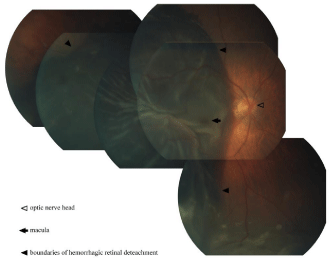Clinical Image
Ophthalmic Risk during Chronic Treatment with Anticoagulants
Joanna Przeździecka-Dołyk1,2*, Andrzej Dołyk3 and Marta Misiuk-Hojło1
1Department and Clinic of Ophthalmology, Medical University of Wroclaw, Poland
2Department of Optics and Photonics, Wrocław University of Science and Technology, Poland
3Department of Angiology, Hypertension and Diabetology, Medical University of Wroclaw, Poland
*Corresponding author: Joanna Przeździecka-Dołyk, Department and Clinic of Ophthalmology, Medical University of Wroclaw, Poland, Rektorat, wybrzeże Ludwika Pasteura 1, 50-367 Wrocław, Poland
Published: 01 Mar, 2017
Cite this article as: Przeździecka-Dołyk J, Dołyk A, Misiuk-
Hojło M. Ophthalmic Risk during
Chronic Treatment with Anticoagulants.
Ann Clin Case Rep. 2017; 2: 1282.
Clinical Image
A 82-years-old female treated with warfarin due to atrial fibrillation(with history of hypertension and myocardial infarction) came to Emergency Ward with rapidly decreased visual acuity in her right eye. 2 weeks ago she had been treated on Emergency Ward with tissue plasminogen activator with bevacizumab and SF6 in intravitreal injection due to submacular haemorrhage in the course of choroidal neovascular membrane. Then she has been referred to her cardiologist to re-evaluate the indications and contraindications of chronic anticoagulant treatment. The re-evaluation according to the Atrial fibrillation guidelines (2016) released by The European Society of Cardiologist has been performed. The patient has been qualified to the treatment with warfarin (CHA2DS2-VASc scale –5 points). No risk of bleeding has been recorded (assessed by HAS-BLED, HEMORR2HAGES, ATRIA, ORBIT and ABC bleeding scores). The anticoagulation therapy with warfarin has been maintained. During fundoscopy the retinal detachment due to subretinal haemorrhage was detected (doubtful light perception).
Funding
Grant for young researchers (Pbmn168).

